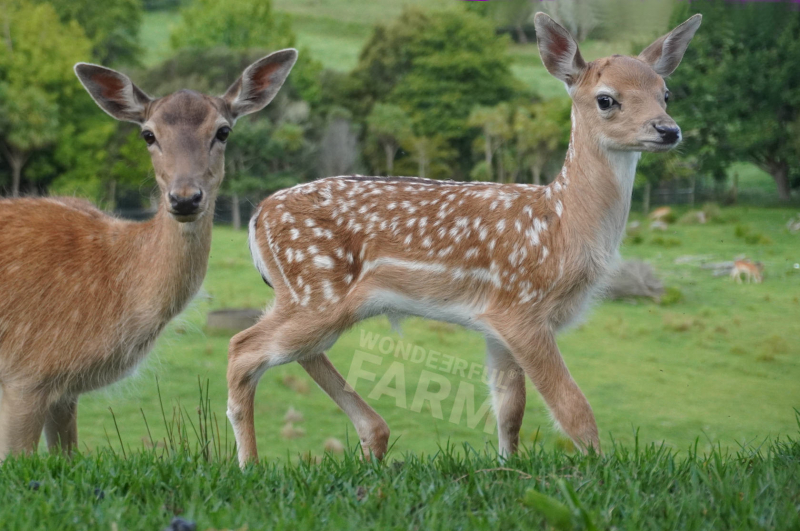- Deer Gestation Period Duration
- How Often Does Deer Reproduction Occur?
- The Importance of Understanding Deer Gestation Periods
- How Many Fawns Can a Doe Have in Her Lifetime?
A healthy deer population can effectively increase its count twofold within a year, assuming there’s abundant food available and they face minimal threats from predators.

Deer typically deliver fawns in late spring, with the majority born either in the final week of May or the initial week of June.
Female deer usually bring forth just one fawn at a time, with newborns weighing between 2 to 4 kilograms and coveref in spots that gradually vanish as they grow older (in case of Fallow deer spots stay on).
Gestation period is the time during which a doe is pregnant. The duration of gestation in deer is contingent upon their species and lasts between roughly 200 and 205 days. In some species, the day count can go as high as 230 or even 290.
Deer Species Gestation Period (days) Fea’s Muntjac 196 Hairy Fronted Munjac 196 Tufted Deer 181 South Andean Deer 213 Indian Muntjac 210 Southern Pudu 210 Indian Hog Deer 220 Red Brocket 225 Calamian Deer 224 Sika Deer 224 Reeve’s Muntjac 214 Sambar Deer 246 Elk 240-262 Eld’s Deer 240 Fallow Deer 230 Mule Deer 203 White-Tail Deer 201 Chital 227 Reindeer 222 Barasingha 245 Red Deer 236 Taruca 236 Javan Rusa 250 Visayan Spotted Deer 243 Brown Brocket 243 Moose 243 Thorold’s Deer 263 Pere David’s Deer 286 Siberian Roe Deer 290 Roe Deer 290
For instance, the gestation period of White-tailed Deer lasts about 200 days. This duration is influenced by the species’ preference for colder habitats. Typically, young female deer (yearlings) give birth to a single fawn, while adult does in excellent physical condition often give birth to twins. [Source link] Spring serves as an optimal time for deer births due to its moderate climate and abundant food resources available for foraging.
The European Fallow Deer (the kind we have on our farm) doe’s gestation period is between 230 and 245 days in length. Usually fawns pop up in a couple of ‘bursts’. First bunch, then in a couple of weeks a second ‘outpouring’ of baby deer.
How Often Does Deer Reproduction Occur?
The frequency of reproduction in white-tailed deer and many other deer species is typically annual. Deer usually reproduce once a year, typically during the breeding season, which is commonly referred to as the rut.
During the rut, which generally occurs in the fall in North America, male deer (bucks) become more active in seeking and competing for mates, while female deer (does) become receptive to mating. Successful mating during this period often leads to pregnancy, and then fawns are typically born in the late spring or early summer, usually about 6 to 7 months later.
While the general pattern is an annual breeding cycle, factors such as food availability, climate conditions, and the health of the population can influence the frequency and success of reproduction in deer. In areas with abundant resources and favorable conditions, deer populations may experience higher reproductive rates. However, in regions where resources are limited, deer populations might exhibit lower reproductive rates.
The Importance of Understanding Deer Gestation Periods
Understanding the gestation period of deer is crucial for hunters and wildlife managers for several reasons:
- Hunting Seasons: Knowledge of the gestation period helps hunters understand when the breeding and fawning seasons occur. This information can influence hunting regulations and seasons, ensuring that hunting activities don’t disrupt breeding or fawning periods, which are critical for sustaining healthy deer populations.
- Population Management: Wildlife managers use data on gestation periods to estimate population sizes and reproductive rates. This knowledge aids in making informed decisions about conservation efforts, population control measures, and habitat management strategies to maintain healthy and sustainable deer populations.
- Conservation Efforts: Understanding the timing of gestation and birth helps in protecting fawning areas. Conservationists and managers can implement measures to safeguard these areas during critical periods to reduce disturbance and increase fawn survival rates.
- Harvest Planning: Hunters who understand gestation periods can make informed decisions about harvesting strategies. They may avoid targeting female deer during certain times to protect pregnant does or to allow fawns to reach a certain age before hunting.
- Overall Population Health: Monitoring gestation periods and reproductive success rates provides insights into the health and productivity of deer populations. Any changes or abnormalities in gestation periods could indicate underlying issues in the ecosystem or population dynamics that need attention.
How Many Fawns Can a Doe Have in Her Lifetime?
A doe (female deer) can potentially produce around 10 to 15 or more fawns throughout its lifetime, depending on factors like its health, lifespan, and environmental conditions. However, the number of surviving fawns can vary due to factors such as predation, disease, habitat quality, and other influences on deer populations.






![Air gun 101: The differences between .177 & .22 – Which jobs they do best ? [Infographic]](https://airgunmaniac.com/wp-content/uploads/2020/09/g44-218x150.jpg)



































